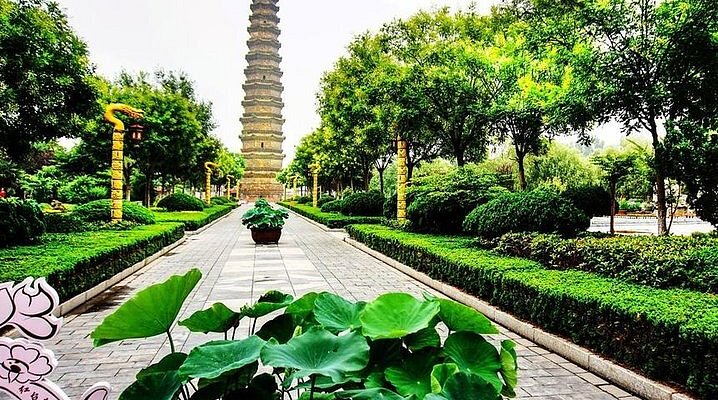Wuzhou Kiln Sites: A Glimpse into the Legacy of Chinese Porcelain

An Essential Guide to Visiting Wuzhou Kiln Sites
Nestled in the heart of China’s Guangxi Zhuang Autonomous Region, Wuzhou is a city steeped in rich history and cultural heritage. Among its many treasures, the Wuzhou Kiln Sites stand out as a remarkable testament to the region’s artisanal excellence and ancient craftsmanship. These kiln sites, dating back to the Tang and Song dynasties, played a pivotal role in the production of exquisite ceramic wares that were highly sought after along the Silk Road.
Visiting the Wuzhou Kiln Sites offers you a unique opportunity to step back in time and immerse yourself in the artistry and techniques that shaped the region’s pottery traditions. As you explore the remnants of these ancient kilns, you will uncover stories of skilled artisans who meticulously crafted porcelain and stoneware, each piece reflecting the vibrant culture and aesthetics of their time.
Whether you’re a history buff, an art enthusiast, or simply a curious traveler, the Wuzhou Kiln Sites provide a fascinating glimpse into a world where fire and clay intertwined to create beauty. This guide will lead you through the essential experiences, tips, and must-visit locations, ensuring that your journey through the kiln sites is both enlightening and memorable. Prepare to be captivated by the past as you wander through this extraordinary landscape of history and creativity.
In This Guide
- An Essential Guide to Visiting Wuzhou Kiln Sites
- The Rich History and Legends of Wuzhou Kiln Sites
- Main Highlights: What You Absolutely Can’t Miss
- Planning Your Visit: A Practical Guide
- Tickets: Prices, Booking, and Tips
- How to Get There: A Complete Transportation Guide
- Local Cuisine and Accommodation Nearby
- Frequently Asked Questions
- Final Thoughts on Your Trip
The Rich History and Legends of Wuzhou Kiln Sites
Nestled in the heart of the Guangxi Zhuang Autonomous Region of China, the Wuzhou Kiln Sites (婺州窑遗址) boast a rich tapestry of history and artistry that dates back over a millennium. These ancient kilns are not merely relics of the past; they are emblematic of Wuzhou’s significant role in the evolution of Chinese ceramics.
The history of the Wuzhou Kiln Sites can be traced back to the Tang Dynasty (618-907 AD), a period renowned for its cultural flourishing and advancements in various art forms. During this time, Wuzhou emerged as a pivotal center for ceramic production, producing exquisite pieces that were sought after across the nation and beyond. The strategic location of Wuzhou, situated along vital trade routes, facilitated the distribution of these ceramics, allowing them to reach markets as far as Japan and Southeast Asia.
As the centuries progressed, the craftsmanship of Wuzhou potters evolved, blending traditional techniques with innovative practices. The kilns produced a diverse array of ceramics, including celadon, which is characterized by its jade-like glaze, and white porcelain, known for its delicate beauty. The products of the Wuzhou kilns were often adorned with intricate designs, reflecting the cultural motifs and aesthetic values of the time.
The legend of the Dragon Mother is deeply intertwined with the Wuzhou Kiln Sites, adding a layer of mystique to this historical locale. Folklore tells of the Dragon Mother, a revered deity who symbolizes fertility and protection. This mythical figure is believed to have nurtured five dragon sons from a stone egg, imbuing the region with a sense of divine significance. The legend is celebrated in various cultural expressions, including temples and festivals, which further enrich the cultural landscape of Wuzhou.
Visitors to the Wuzhou Kiln Sites can explore the remains of these ancient kilns, where the remnants of a once-thriving ceramic industry tell stories of artistry and innovation. The sites are a testament to the skills of artisans who dedicated their lives to perfecting their craft, and they offer a glimpse into the daily lives of those who lived and worked in this vibrant community.
Today, the Wuzhou Kiln Sites are not just archaeological treasures; they are a pilgrimage for ceramic enthusiasts and history buffs alike. As you wander through the remnants of the kilns, the air is thick with the echoes of the past, transporting you to a time when these artisans shaped not just clay, but the very fabric of Chinese culture.
In essence, the Wuzhou Kiln Sites serve as a bridge between history and modernity, inviting travelers from around the world to appreciate the rich legacy of ceramic craftsmanship that continues to inspire and captivate. Whether you’re an avid collector or simply a curious wanderer, a visit to these historic kilns promises to be a memorable journey into the heart of Chinese heritage.

Wuzhou Kiln Sites.
Main Highlights: What You Absolutely Can’t Miss
Wuzhou, renowned for its rich history of porcelain production, is home to the fascinating Wuzhou Kiln Sites (婺州窑遗址). These ancient sites not only reveal the artistry and craftsmanship of Chinese ceramics but also offer a glimpse into the cultural heritage of the region. Here are the key highlights that you absolutely cannot miss during your visit:
1. The Kiln Ruins
Explore the remnants of the ancient kilns where artisans meticulously crafted exquisite ceramics over a millennium ago. The site showcases various kiln types, including dragon kilns, which were essential for firing large quantities of pottery. Walking through these historical ruins allows you to appreciate the innovative techniques employed by ancient potters and the significance of ceramics in daily life and trade.
2. Wuzhou Museum
Situated nearby, the Wuzhou Museum houses a remarkable collection of artifacts, including ancient ceramics from the Wuzhou Kiln Sites. The museum provides context on the evolution of porcelain production in the area, illustrating how these beautiful objects were not just utilitarian but also played a key role in cultural exchanges along trade routes.
3. Dragon Mother Temple (Longmu Imperial Ancestral Temple)
Visit the Dragon Mother Temple, dedicated to the legendary Dragon Mother, a symbol of protection and fertility. The temple features a stunning 38-meter statue of the Dragon Mother, surrounded by serene gardens. This site is not only a spiritual sanctuary but also a place to reflect on the rich folklore connected to the region’s heritage.
4. Qilou Building
Step into the historic Qilou Building, also known as Arcade City, renowned for its unique architecture and vibrant atmosphere. This area, with its arcade streets and colonial-era buildings, offers a glimpse into Wuzhou’s prosperous past as a trading hub. It’s a perfect spot to wander, shop for local crafts, and enjoy traditional refreshments.
5. Hebin Park
Just a stone’s throw from the kiln sites, Hebin Park provides a picturesque setting for relaxation and leisure. Stroll along the scenic riverbanks, visit the white crane pagoda, and enjoy the views of the surrounding landscape. The park is ideal for a peaceful break after exploring the historical sites.
6. Cultural Experiences
Engage in workshops and demonstrations that showcase traditional pottery-making techniques. Many local artisans welcome visitors to their studios, allowing you to try your hand at crafting your own piece of pottery, deepening your appreciation for this ancient art form.
7. Local Cuisine
Don’t miss the chance to savor Wuzhou’s unique culinary offerings. Sample local delicacies such as rice noodles and fresh river fish, which can be found in nearby eateries. Pair your meal with a cup of local tea to complete your cultural experience.
8. Scenic River Cruises
For a different perspective of Wuzhou, consider taking a river cruise along the West River. This leisurely journey offers breathtaking views of the city’s skyline and surrounding mountains, making it a perfect way to unwind after a day of exploration.
Conclusion
The Wuzhou Kiln Sites and their surroundings offer a captivating blend of history, culture, and artistry. Whether you are fascinated by ancient ceramics, interested in local legends, or simply seeking a serene escape, Wuzhou promises an enriching travel experience that you will cherish long after your visit.

Wuzhou Kiln Sites.
Planning Your Visit: A Practical Guide
Visiting the Wuzhou Kiln Sites, a treasure trove of ancient ceramic history, is a delightful experience for any traveler intrigued by China’s rich cultural heritage. This guide will help you plan your visit, ensuring you make the most of your time at this fascinating destination.
Getting There
Wuzhou is conveniently located in southern China, making it accessible from major cities like Guangzhou and Guilin. The city has a well-connected transport network, including trains and buses.
- By Train: High-speed trains from Guangzhou to Wuzhou take approximately 2.5 hours. Check schedules in advance to secure your tickets.
- By Bus: Numerous bus services operate between Wuzhou and surrounding cities. This option is often economical and provides a chance to see the countryside.
Best Time to Visit
The ideal time to explore the Wuzhou Kiln Sites is during the spring (March to May) and autumn (September to November) months when the weather is mild and pleasant. Summers can be hot and humid, while winters are relatively cooler but still manageable.
Accommodation
Wuzhou offers various accommodation options, from budget hostels to comfortable hotels. Here are a few recommendations:
- Wuzhou International Hotel: A popular choice for its central location and modern amenities.
- Jinjiang Inn Wuzhou: A budget-friendly option with clean rooms and good service.
- Local Guesthouses: For a more authentic experience, consider staying in a local guesthouse, which can provide insights into the regional culture.
Exploring the Kiln Sites
The Wuzhou Kiln Sites are best explored with a guided tour, which can provide valuable context and stories behind the ancient ceramics. Here are some key highlights:
- The Main Excavation Site: Witness the remnants of ancient kilns where artisans crafted beautiful pottery. Look for the unique blue-and-white porcelain that Wuzhou is famous for.
- Museum of Ceramics: Adjacent to the kiln sites, this museum houses an extensive collection of artifacts, showcasing the evolution of ceramics in the region.
- Workshops: Participate in a pottery-making workshop to try your hand at creating your own piece of art, guided by skilled artisans.
Additional Attractions
While in Wuzhou, don’t miss these nearby attractions:
- Wuzhou Mt. Baiyun Park: A scenic park offering hiking trails and beautiful views. The park is perfect for a day of exploration.
- Qilou Building: Known for its unique architectural style, this area is often referred to as Arcade City, showcasing over 100 years of history.
- Longmu Imperial Ancestral Temple: A serene temple dedicated to the Dragon Mother, featuring stunning architecture and a peaceful atmosphere.
Culinary Delights
Wuzhou has a vibrant food scene that you shouldn’t miss. Consider trying:
- Local Noodles: Wuzhou’s specialty noodles are a must-try.
- Street Food: Sample local snacks from vendors while exploring the city.
- Tea Houses: Experience traditional Chinese tea culture at one of Wuzhou’s many tea houses.
Transportation Within Wuzhou
Getting around Wuzhou is easy and affordable. Options include:
- Public Buses: A convenient way to navigate the city, with routes covering major attractions.
- Taxis and Ride-Sharing: Taxis are plentiful, and apps like Didi (the Chinese equivalent of Uber) are widely used.
- Bicycles: For a more eco-friendly option, consider renting a bicycle to explore the local area at your own pace.
Tips for Travelers
- Language: While some locals may speak basic English, learning a few Mandarin phrases can enhance your experience.
- Cash: While many places accept mobile payments, it’s wise to carry some cash for smaller vendors.
- Cultural Respect: Be mindful of local customs and traditions, especially when visiting religious sites.
With its ancient history, stunning landscapes, and rich culture, Wuzhou and its Kiln Sites promise a memorable journey. By following this guide, you’ll be well-equipped to immerse yourself in the wonders of this remarkable destination. Happy travels!

Wuzhou Kiln Sites.
Tickets: Prices, Booking, and Tips
When planning your visit to the Wuzhou Kiln Sites (婺州窑遗址), knowing the ticket prices and booking options will help streamline your experience. Here’s everything you need to know about tickets, along with some valuable tips to enhance your visit.
Ticket Prices
The Wuzhou Kiln Sites typically offer affordable entry fees, making it accessible for travelers on various budgets. While the exact prices may fluctuate based on special exhibitions or events, you can generally expect the following:
- Standard Admission: Approximately 30 yuan for adults
- Discounted Admission: Students, children, and seniors often enjoy reduced rates, typically around 15 yuan.
It’s advisable to carry some cash, as not all ticket counters may accept card payments.
Booking Tickets
You can purchase tickets directly at the entrance of the Wuzhou Kiln Sites, which allows for flexibility in your travel plans. However, during peak tourist seasons or on weekends, it’s wise to arrive early to avoid long lines.
For those who prefer to secure their visit in advance, consider using travel booking platforms like Trip.com or local tourism websites. These platforms often provide exclusive offers and discounts, especially if you book as part of a larger itinerary or tour.
Tips for Your Visit
-
Plan Your Visit Timing: Early mornings or late afternoons are ideal for visiting to avoid crowds and to enjoy the beautiful lighting for photography.
-
Explore Nearby Attractions: The Wuzhou Kiln Sites are part of a rich cultural landscape. Combine your visit with nearby attractions like the Longmu Imperial Ancestral Temple or the Qilou Building for a full day of exploration.
-
Guided Tours: For a deeper understanding of the historical significance of the kiln sites, consider joining a guided tour. These tours often include insights from knowledgeable guides and can enhance your appreciation of the craftsmanship and history.
-
Stay Hydrated and Wear Comfortable Shoes: The sites can involve quite a bit of walking, so bringing water and wearing comfortable footwear will make your visit more enjoyable.
By keeping these tips in mind, you can ensure a smooth and enjoyable experience at the Wuzhou Kiln Sites, immersing yourself in the artistry and history of this remarkable destination.
How to Get There: A Complete Transportation Guide
Reaching the Wuzhou Kiln Sites, a splendid historical treasure located in Guangxi, China, is an adventure in itself. Below is a comprehensive guide designed to help international travelers navigate their way to this captivating destination.
Arriving in Wuzhou
By Air
The nearest major airport to Wuzhou is Wuzhou Changzhou Airport (WUZ). Although it primarily serves domestic routes, you can reach Wuzhou via connecting flights from larger hubs like Guangzhou Baiyun International Airport (CAN) or Shenzhen Bao’an International Airport (SZX).
- From Guangzhou: There are daily flights to Wuzhou, which take about 1 hour. Once you arrive, taxis or ride-sharing services can take you to the city center or directly to the kiln sites.
- From Shenzhen: Similar to Guangzhou, you can find flights that take approximately 1 hour. After landing, taxis are readily available.
By Train
Wuzhou is well-connected by rail. The Wuzhou Railway Station offers services to and from several major cities:
- From Guangzhou: High-speed trains operate frequently, with travel times around 2.5 to 3 hours. Trains typically depart from Guangzhou South Railway Station (广州南).
- From Nanning: Direct trains are available as well, taking about 4 hours.
- From Guilin: Trains from Guilin to Wuzhou take around 2 hours.
Once you arrive at Wuzhou Railway Station, public buses and taxis can be used to access the kiln sites.
By Bus
For budget-conscious travelers, long-distance buses are a viable option. Several bus companies operate routes to Wuzhou from nearby cities:
- From Guangzhou: Buses depart from the Guangzhou Provincial Bus Station and take approximately 4 to 5 hours.
- From Guilin: The journey takes about 3 to 4 hours, with multiple departures daily.
Buses will arrive at the Wuzhou Long Distance Bus Station, which is conveniently located close to the city center.
Getting to the Kiln Sites
Once you have arrived in Wuzhou, here are the best ways to reach the Kiln Sites:
By Taxi
Taxis are the most straightforward option. Simply tell the driver “Wuzhou Kiln Sites” (婺州窑遗址) to ensure you are taken directly there. Taxis are affordable and readily available throughout the city.
By Public Transportation
For those looking to experience local transportation, buses are available, though they may require some navigation and local knowledge.
- Bus Routes: Check with your accommodation or a local information center for the most current bus routes heading towards the kiln sites.
- Duration: Depending on traffic and the specific bus route, you can expect about 30 minutes to an hour for the journey.
Guided Tours
For a more enriched experience, consider joining a guided tour. Many tour operators offer packages that include transportation to the kiln sites along with a knowledgeable guide to provide context and history. This is particularly beneficial for those who wish to explore the surrounding attractions as well.
Conclusion
Traveling to the Wuzhou Kiln Sites is an accessible and enjoyable journey, whether you choose to fly, take the train, or embark on a bus adventure. With multiple options available for getting around Wuzhou, you’ll find it easy to explore this historical gem at your own pace. Be sure to plan ahead to make the most of your visit to this fascinating site that showcases the rich heritage of porcelain production in China.

Wuzhou Kiln Sites.
Local Cuisine and Accommodation Nearby
When visiting the historic Wuzhou Kiln Sites, indulge in the local flavors and enjoy comfortable accommodations that reflect the charm of this region. Here’s a guide to some of the best dining and lodging options nearby that will enhance your cultural experience.
Local Cuisine
Wuzhou’s culinary scene is a delightful mix of traditional Guangxi flavors, featuring an array of dishes that celebrate the region’s rich agricultural heritage. Here are a few must-try dishes and restaurants:
-
Wuzhou Rice Noodles (肠粉): A local specialty, these rice noodles are often served with various toppings. Head to Wuzhou Noodle House, known for its authentic preparation and delicious variations.
-
Sweet and Sour Fish: A popular dish in the region, this is a must-try for seafood lovers. You can find excellent versions at Lao Wang’s Fish Restaurant, where the fish is fresh and cooked to perfection.
-
Steamed Dumplings: For a quick snack, try the dumplings from Dumpling Street Stall, where you can choose from a variety of fillings and enjoy them fresh off the steamer.
-
Local Tea: Don’t miss sampling some of Guangxi’s famous teas. Tea House by the River offers a serene setting to sip on local brews while enjoying views of the surrounding landscape.
Accommodation Nearby
After a day of exploring the Wuzhou Kiln Sites and soaking in the local culture, unwind at one of these nearby accommodations:
-
Wuzhou International Hotel: A comfortable and modern hotel featuring spacious rooms and a panoramic view of the city. With amenities such as an on-site restaurant and fitness center, this hotel is perfect for travelers seeking convenience and comfort.
-
Baiyun Hotel: Located close to the Wuzhou Kiln Sites, this hotel offers cozy rooms with traditional decor. Guests enjoy easy access to local attractions and a complimentary breakfast that includes regional specialties.
-
Wuzhou Backpacker Hostel: For budget-conscious travelers, this hostel provides a friendly atmosphere and shared facilities. It’s an excellent place to meet fellow travelers and exchange stories after a day of adventure.
-
Riverside Boutique Hotel: If you’re looking for something more upscale, this boutique hotel features elegant rooms and personalized service. Enjoy the stunning river views and a relaxing stay in a beautifully designed space.
Conclusion
With its delectable local cuisine and comfortable accommodations, Wuzhou provides a perfect base for exploring the fascinating Kiln Sites. Whether you’re feasting on traditional dishes or resting in a cozy hotel, your journey through this historic region will be enriched by the flavors and hospitality of Wuzhou.

Wuzhou Kiln Sites.
Frequently Asked Questions
Frequently Asked Questions for Travelers to Wuzhou Kiln Sites
1. What are the Wuzhou Kiln Sites?
The Wuzhou Kiln Sites, located in the Guangxi region of China, are historical remnants of ancient ceramic production. They date back to the Tang and Song dynasties and are renowned for their exquisite craftsmanship in porcelain and pottery, making them a significant part of China’s cultural heritage.
2. How can I reach the Wuzhou Kiln Sites?
The Wuzhou Kiln Sites are easily accessible by public transportation. You can take a bus or taxi from central Wuzhou to the site. If you’re traveling from major cities like Guangzhou or Guilin, consider a private tour or a train to Wuzhou, followed by local transport to the sites.
3. What is the best time to visit the Wuzhou Kiln Sites?
The ideal time to visit is during the spring (March to May) and autumn (September to November) when the weather is mild and pleasant. Avoid the peak summer months when temperatures can soar, making outdoor exploration less enjoyable.
4. Are there any entrance fees for the Wuzhou Kiln Sites?
Yes, there is typically a small entrance fee to access the Wuzhou Kiln Sites. Prices may vary, so it’s a good idea to check in advance or inquire at the local tourist information center.
5. What should I wear when visiting the Wuzhou Kiln Sites?
Comfortable clothing and sturdy walking shoes are recommended, as you will likely be walking on uneven terrain. If visiting during warmer months, consider wearing a hat and sunscreen, and bring water to stay hydrated.
6. Can I take photographs at the Wuzhou Kiln Sites?
Yes, photography is generally allowed at the Wuzhou Kiln Sites. However, be respectful of the cultural significance and any signage regarding photography restrictions, especially in specific temple areas.
7. Are there guided tours available at the Wuzhou Kiln Sites?
Yes, guided tours are available and can greatly enhance your experience by providing insights into the history and significance of the sites. Check with local tour operators or your hotel for recommendations.
8. What other attractions are nearby the Wuzhou Kiln Sites?
In addition to the kiln sites, you can explore other attractions such as the Longmu Imperial Ancestral Temple, the beautiful parks in Wuzhou, and historical sites like the Qilou Building. Combining these visits can make for a rich cultural experience in the region.
Final Thoughts on Your Trip
As you wrap up your exploration of the Wuzhou Kiln Sites, take a moment to reflect on the rich tapestry of history, culture, and artistry that surrounds you. These ancient kilns are not merely remnants of a bygone era; they are a testament to the remarkable craftsmanship that has shaped the region’s identity over centuries.
Wuzhou’s allure extends beyond its ceramic heritage, offering a harmonious blend of natural beauty and cultural treasures. From the serene landscapes of Mount Baiyun to the bustling streets adorned with Qilou architecture, this city invites you to dive deeper into its stories and traditions.
Whether you’ve wandered through the tranquil temples, strolled along the vibrant parks, or marveled at the intricate designs of the ceramics, each experience contributes to a profound understanding of Wuzhou’s legacy. As you prepare to leave, carry with you not just souvenirs, but the spirit of a city that continues to inspire creativity and connection.
So, as you pack your bags, remember to look back at the beautiful moments you’ve captured and the stories you’ll take home. Wuzhou is more than a destination—it’s a journey through time that will linger in your heart long after you’ve returned. Safe travels, and may your adventures continue to inspire!